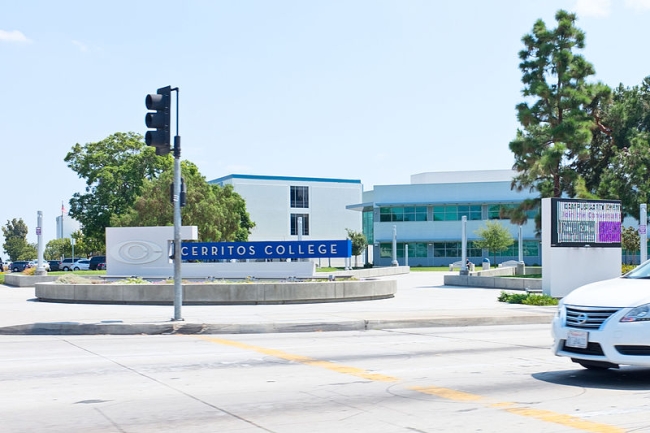You have /5 articles left.
Sign up for a free account or log in.

Wikimedia Commons/Northwalker
Cerritos College was Sunny Saldana's life before the COVID-19 pandemic hit.
The 29-year-old mother was at the two-year college's campus in Norwalk, Calif., from 8 a.m. until 7 p.m. Her job was on campus, and she would study on campus.
"My rule that I made myself was to do school at school and not take it home with me," Saldana said.
Once she got home in the evening, she had time to help her 9-year-old daughter with homework and spend time with her.
Then the pandemic hit, and suddenly the campus was closed.
"It was a shock to everyone," she said. "I remember going into my class and my teacher was like, 'I’m not gonna see you guys anymore.'"
It was hard for Saldana to balance parenting, going to college and working all from home. She quickly realized she had to become her daughter's teacher in the spring, she said. Once summer rolled around, she lost her work-study job.
By the end of the spring semester, Saldana was discouraged. But support and aid from the college in the form of emergency grants, food donations and more are what kept her on track to graduate.
"Going through this made me appreciate my school so much more," she said. "Being a community college, it feels more like a family."
Community colleges tend to serve the most vulnerable student populations, such as low-income or first-generation students. They also serve more students of color, particularly Latinx students.
People of color -- in particular Black and Latinx people -- are more likely to contract the coronavirus and more likely to die from it, studies show, leaving these students more vulnerable than ever.
"It's an equity issue," said Wil Del Pilar, vice president of higher education policy and practice at the Education Trust, an advocacy organization in Washington, D.C.
Research shows that public colleges spend, on average, $1,000 less per student of color annually than they do on white students, he said. This is partly because students of color are more likely to attend community colleges, which don't get adequate support financial support from states.
On top of the historic underfunding of community colleges, people of color are also facing greater impacts from the pandemic, Del Pilar said. Unemployment rates for people of color are higher and students of color have less access to the technology and internet necessary to learn remotely.
‘Overwhelming Need’
About 65 percent of the students served by Cerritos College are Latinx. The college has been gathering information through surveys and aid applications to determine what students need most during this time, said Dilcie Perez, vice president of student services.
More than one-quarter of their students had challenges related to technology, she said, and many had concerns about finding a quiet place to study while living at home with family members.
To address those issues, the college has given away 300 laptops and just placed an order for 200 more, Perez said. The campus gym is now a study hall for the fall, where students can sign up for two-hour increments of study time at tables placed 10 feet apart.
The college may have been better prepared for this crisis than others, Perez said. Because Cerritos has always served a more vulnerable population, it already had solutions in place, like a basic needs task force and a case manager.
Saldana had two counselors who kept her going during the spring and summer, she said.
"Sometimes you need someone to cheer you on," she said. "That support made me not want to let anybody down."
The need has greatly increased since the pandemic hit, though.
Usually, the college would have about 250 people attend events for receiving food. Once the pandemic started, 1,300 people were coming to Cerritos to get boxes of food placed in their car trunks, Perez said. The college has also given out more than 500 gift cards to grocery stores since COVID-19 began.
"At this time, it can feel overwhelming to really hear all of the needs of students," Perez said. "For us and for me, it’s important that I know I might not be able to meet every need, but I can do what I can. Our goal will always be to do more and identify additional resources."
Taking Things for Granted
Latoya Jackson was close to stopping out of Reynolds Community College in Virginia due to the pandemic, even though she is set to graduate in October. With four children at home, Jackson, 29, wasn't able to keep her job. Her computer was broken, and she had bills to pay.
"I went up there and talked with the adviser, and she gave me a rundown and told me not to quit," Jackson said. "They were very convincing to not give up."
So Jackson stuck with it. Reynolds gave her a loan so she could pay her bills, as well as a computer so she could work online. Her adviser helped her find resources in the community, like food and childcare.
Her professors also provided emotional support, Jackson said. The college and its staff ended up being the people she could count on during this time, she said.
Paula Pando, president of Reynolds, believes community colleges were built for this moment.
She has three college-aged children. All of them were able to return home in the spring to their own rooms and laptops. The house has internet and a full fridge, and both of their parents are college-educated.
"Many of the students we serve have none of the above," Pando said. "All of the things that many of us take for granted."
The college decided to not try to address every need, but rather target certain needs in a "narrow and deep" way, she said. Those included a laptop loaner program and internet expansion into parking lots for students, as well as mentoring programs for Black students.
The campus is also open four days per week to provide critical support services, like advising, financial aid and disability services, because some students need to be in-person, she said. Classrooms and the library are also now open, with limited seating options for students.
They looked to the community to fill other needs. Students are referred to a local community agency that provides food assistance. The college's foundation raised money to help students pay bills.
Pando is also looking at the enrollment data to see who's coming back. She's watching to see if they enroll more new students, those who would typically go to four-year colleges but have decided to stay local instead due to the pandemic.
"My focus is on the student populations who need us the most," she said. "We have to remember three things: who we are, who we serve and why we serve them. Everything else is negotiable."
High Costs, Low Funding
Funding is always a major concern for colleges, particularly when the supports that best serve their students tend to be expensive.
One of the most powerful supports is the City University of New York's Accelerated Study in Associate Programs, or ASAP, said Maithreyi Gopalan, assistant professor of education at Pennsylvania State University. But even that program is at risk of being on the chopping block, according to proposed city budget cuts.
"That is one of my strongest worries in this situation," Gopalan said. "Institutions should not try to take low-cost approaches right now, when we need a lot of high-touch interventions."
At Reynolds, Pando said that funding is always a concern. But her decision to eliminate executive positions when she began as president has helped boost resources for students.
"We all want more resources, and we will fight for them," she said. "But the bottom line is, we have resources -- we just need to better allocate them."
Del Pilar argues that community colleges shouldn't have to continue doing more with less. At the federal level, the next stimulus bill could use student count instead of full-time-equivalent enrollment counts to more adequately fund two-year colleges. Doubling the federal Pell Grant maximum would also help community college students, he said.
States can also do more to better fund community colleges. They could include equity measurements in funding formulas, create free college programs that use first-dollar models and make state grant aid accessible to two-year college students, Del Pilar said.
While institutions could do more for equity as well, such as extending debt forgiveness to stopped-out students, creating wraparound supports and closely analyzing data, they ultimately need more support, he said.
"We expect community colleges to be resilient instead of ensuring that we provide supports," he said. "Community colleges have been forced to have to do this because we have continuously underfunded them."
That may be because the students who tend to enroll at two-year colleges aren't seen as deserving as those who tend to enroll at state flagship institutions, Del Pilar said.
"We should be flipping the formula on its head," he said.








